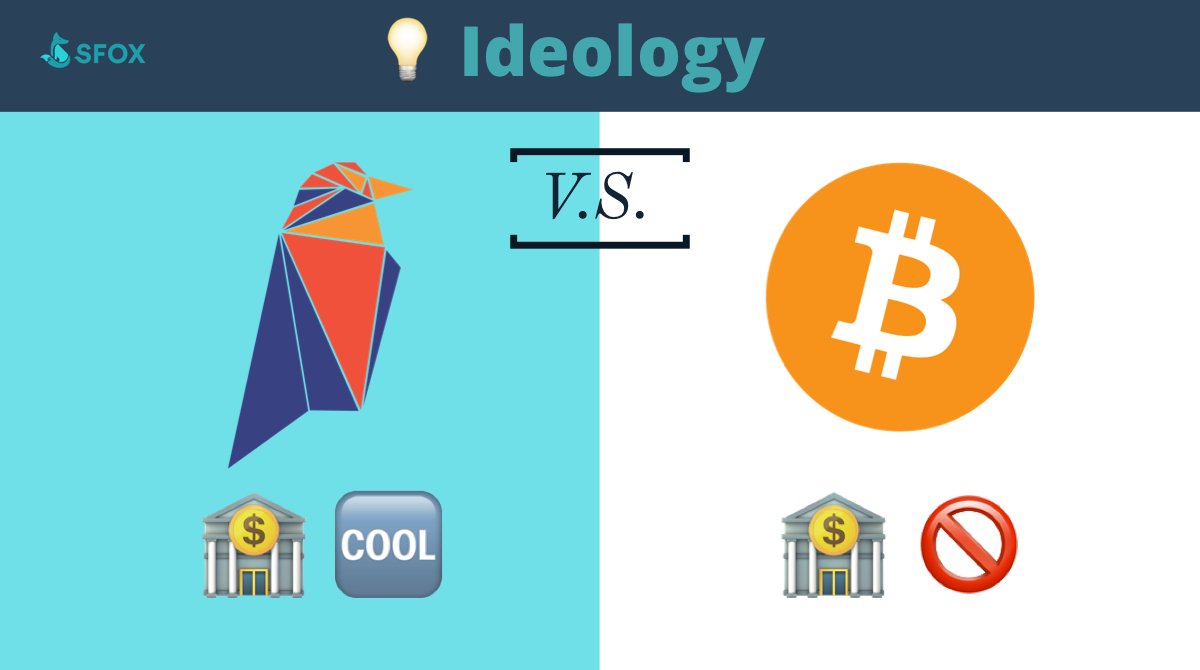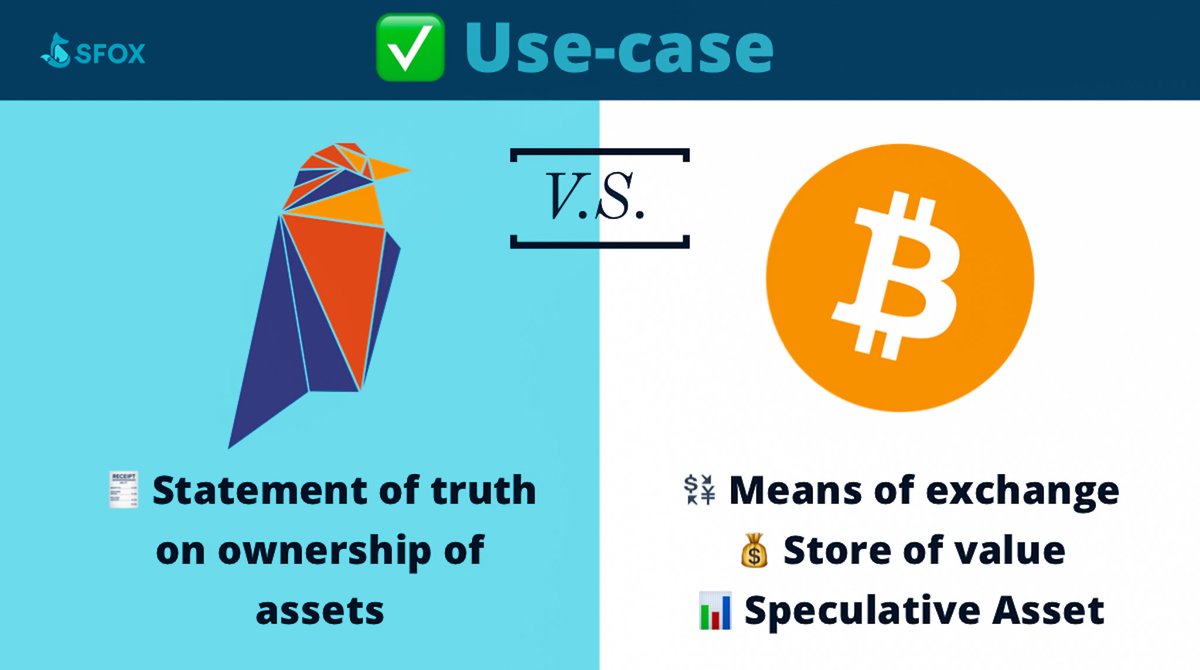How exactly does the @Ravencoin fork differ from the original #Bitcoin  https://abs.twimg.com/hashflags... draggable="false" alt="">?
https://abs.twimg.com/hashflags... draggable="false" alt="">?
A https://abs.twimg.com/emoji/v2/... draggable="false" alt="🧵" title="Thread" aria-label="Emoji: Thread">...
https://abs.twimg.com/emoji/v2/... draggable="false" alt="🧵" title="Thread" aria-label="Emoji: Thread">...
A
1/  https://abs.twimg.com/emoji/v2/... draggable="false" alt="💡" title="Electric light bulb" aria-label="Emoji: Electric light bulb"> Ideology
https://abs.twimg.com/emoji/v2/... draggable="false" alt="💡" title="Electric light bulb" aria-label="Emoji: Electric light bulb"> Ideology
#RVN aims to facilitate collaboration with financial institutions.
#BTC https://abs.twimg.com/hashflags... draggable="false" alt=""> was created to address people’s lack of trust in financial institutions.
https://abs.twimg.com/hashflags... draggable="false" alt=""> was created to address people’s lack of trust in financial institutions.
#RVN aims to facilitate collaboration with financial institutions.
#BTC
2/  https://abs.twimg.com/emoji/v2/... draggable="false" alt="✅" title="White heavy check mark" aria-label="Emoji: White heavy check mark"> Use-Case
https://abs.twimg.com/emoji/v2/... draggable="false" alt="✅" title="White heavy check mark" aria-label="Emoji: White heavy check mark"> Use-Case
#RVN carries statements of truth about who owns what assets, regulated or unregulated (the platform supports both).
#BTC https://abs.twimg.com/hashflags... draggable="false" alt=""> can be used as a means of exchange, a store of value, and a speculative asset, among other uses.
https://abs.twimg.com/hashflags... draggable="false" alt=""> can be used as a means of exchange, a store of value, and a speculative asset, among other uses.
#RVN carries statements of truth about who owns what assets, regulated or unregulated (the platform supports both).
#BTC
3/  https://abs.twimg.com/emoji/v2/... draggable="false" alt="📐" title="Triangular ruler" aria-label="Emoji: Triangular ruler"> Scalability
https://abs.twimg.com/emoji/v2/... draggable="false" alt="📐" title="Triangular ruler" aria-label="Emoji: Triangular ruler"> Scalability
#RVN is unlikely to have an issue with scaling in the near future thanks to its faster block times and larger blocks.
#BTC https://abs.twimg.com/hashflags... draggable="false" alt=""> favors second-layer solutions like SegWit and the #LightningNetwork to tackle scaling.
https://abs.twimg.com/hashflags... draggable="false" alt=""> favors second-layer solutions like SegWit and the #LightningNetwork to tackle scaling.
#RVN is unlikely to have an issue with scaling in the near future thanks to its faster block times and larger blocks.
#BTC
4/  https://abs.twimg.com/emoji/v2/... draggable="false" alt="⛏" title="Pick" aria-label="Emoji: Pick"> Mining
https://abs.twimg.com/emoji/v2/... draggable="false" alt="⛏" title="Pick" aria-label="Emoji: Pick"> Mining
#RVN currently uses X16R algorithm—but, as it has recently proved unsuccessful in being ASIC-resistant, a hard fork will occur on May 6th to a KawPow algorithm.
#BTC https://abs.twimg.com/hashflags... draggable="false" alt=""> uses the SHA-256 algorithm to reach network consensus, and is therefore not ASIC-resistant.
https://abs.twimg.com/hashflags... draggable="false" alt=""> uses the SHA-256 algorithm to reach network consensus, and is therefore not ASIC-resistant.
#RVN currently uses X16R algorithm—but, as it has recently proved unsuccessful in being ASIC-resistant, a hard fork will occur on May 6th to a KawPow algorithm.
#BTC
5/ On April 6th, @Ravencoin developer @tronblack looked forward to the upcoming consensus change with the following observation:
6/  https://abs.twimg.com/emoji/v2/... draggable="false" alt="📖" title="Open book" aria-label="Emoji: Open book"> Read our full comprehensive, data-packed analysis comparing #RVN
https://abs.twimg.com/emoji/v2/... draggable="false" alt="📖" title="Open book" aria-label="Emoji: Open book"> Read our full comprehensive, data-packed analysis comparing #RVN  https://abs.twimg.com/emoji/v2/... draggable="false" alt="🦅" title="Eagle" aria-label="Emoji: Eagle"> V.S. #BTC
https://abs.twimg.com/emoji/v2/... draggable="false" alt="🦅" title="Eagle" aria-label="Emoji: Eagle"> V.S. #BTC  https://abs.twimg.com/hashflags... draggable="false" alt="">
https://abs.twimg.com/hashflags... draggable="false" alt="">  https://abs.twimg.com/emoji/v2/... draggable="false" alt="⤵️" title="Arrow pointing rightwards then curving downwards" aria-label="Emoji: Arrow pointing rightwards then curving downwards"> https://bit.ly/SFOX_RVN_BTC ">https://bit.ly/SFOX_RVN_...
https://abs.twimg.com/emoji/v2/... draggable="false" alt="⤵️" title="Arrow pointing rightwards then curving downwards" aria-label="Emoji: Arrow pointing rightwards then curving downwards"> https://bit.ly/SFOX_RVN_BTC ">https://bit.ly/SFOX_RVN_...

 Read on Twitter
Read on Twitter ? Ahttps://abs.twimg.com/emoji/v2/... draggable="false" alt="🧵" title="Thread" aria-label="Emoji: Thread">..." title="How exactly does the @Ravencoin fork differ from the original #Bitcoin https://abs.twimg.com/hashflags... draggable="false" alt="">? Ahttps://abs.twimg.com/emoji/v2/... draggable="false" alt="🧵" title="Thread" aria-label="Emoji: Thread">..." class="img-responsive" style="max-width:100%;"/>
? Ahttps://abs.twimg.com/emoji/v2/... draggable="false" alt="🧵" title="Thread" aria-label="Emoji: Thread">..." title="How exactly does the @Ravencoin fork differ from the original #Bitcoin https://abs.twimg.com/hashflags... draggable="false" alt="">? Ahttps://abs.twimg.com/emoji/v2/... draggable="false" alt="🧵" title="Thread" aria-label="Emoji: Thread">..." class="img-responsive" style="max-width:100%;"/>
 Ideology #RVN aims to facilitate collaboration with financial institutions. #BTC https://abs.twimg.com/hashflags... draggable="false" alt=""> was created to address people’s lack of trust in financial institutions." title="1/ https://abs.twimg.com/emoji/v2/... draggable="false" alt="💡" title="Electric light bulb" aria-label="Emoji: Electric light bulb"> Ideology #RVN aims to facilitate collaboration with financial institutions. #BTC https://abs.twimg.com/hashflags... draggable="false" alt=""> was created to address people’s lack of trust in financial institutions." class="img-responsive" style="max-width:100%;"/>
Ideology #RVN aims to facilitate collaboration with financial institutions. #BTC https://abs.twimg.com/hashflags... draggable="false" alt=""> was created to address people’s lack of trust in financial institutions." title="1/ https://abs.twimg.com/emoji/v2/... draggable="false" alt="💡" title="Electric light bulb" aria-label="Emoji: Electric light bulb"> Ideology #RVN aims to facilitate collaboration with financial institutions. #BTC https://abs.twimg.com/hashflags... draggable="false" alt=""> was created to address people’s lack of trust in financial institutions." class="img-responsive" style="max-width:100%;"/>
 Use-Case #RVN carries statements of truth about who owns what assets, regulated or unregulated (the platform supports both). #BTC https://abs.twimg.com/hashflags... draggable="false" alt=""> can be used as a means of exchange, a store of value, and a speculative asset, among other uses." title="2/ https://abs.twimg.com/emoji/v2/... draggable="false" alt="✅" title="White heavy check mark" aria-label="Emoji: White heavy check mark"> Use-Case #RVN carries statements of truth about who owns what assets, regulated or unregulated (the platform supports both). #BTC https://abs.twimg.com/hashflags... draggable="false" alt=""> can be used as a means of exchange, a store of value, and a speculative asset, among other uses." class="img-responsive" style="max-width:100%;"/>
Use-Case #RVN carries statements of truth about who owns what assets, regulated or unregulated (the platform supports both). #BTC https://abs.twimg.com/hashflags... draggable="false" alt=""> can be used as a means of exchange, a store of value, and a speculative asset, among other uses." title="2/ https://abs.twimg.com/emoji/v2/... draggable="false" alt="✅" title="White heavy check mark" aria-label="Emoji: White heavy check mark"> Use-Case #RVN carries statements of truth about who owns what assets, regulated or unregulated (the platform supports both). #BTC https://abs.twimg.com/hashflags... draggable="false" alt=""> can be used as a means of exchange, a store of value, and a speculative asset, among other uses." class="img-responsive" style="max-width:100%;"/>
 Scalability #RVN is unlikely to have an issue with scaling in the near future thanks to its faster block times and larger blocks. #BTC https://abs.twimg.com/hashflags... draggable="false" alt=""> favors second-layer solutions like SegWit and the #LightningNetwork to tackle scaling." title="3/ https://abs.twimg.com/emoji/v2/... draggable="false" alt="📐" title="Triangular ruler" aria-label="Emoji: Triangular ruler"> Scalability #RVN is unlikely to have an issue with scaling in the near future thanks to its faster block times and larger blocks. #BTC https://abs.twimg.com/hashflags... draggable="false" alt=""> favors second-layer solutions like SegWit and the #LightningNetwork to tackle scaling." class="img-responsive" style="max-width:100%;"/>
Scalability #RVN is unlikely to have an issue with scaling in the near future thanks to its faster block times and larger blocks. #BTC https://abs.twimg.com/hashflags... draggable="false" alt=""> favors second-layer solutions like SegWit and the #LightningNetwork to tackle scaling." title="3/ https://abs.twimg.com/emoji/v2/... draggable="false" alt="📐" title="Triangular ruler" aria-label="Emoji: Triangular ruler"> Scalability #RVN is unlikely to have an issue with scaling in the near future thanks to its faster block times and larger blocks. #BTC https://abs.twimg.com/hashflags... draggable="false" alt=""> favors second-layer solutions like SegWit and the #LightningNetwork to tackle scaling." class="img-responsive" style="max-width:100%;"/>
 Mining #RVN currently uses X16R algorithm—but, as it has recently proved unsuccessful in being ASIC-resistant, a hard fork will occur on May 6th to a KawPow algorithm. #BTC https://abs.twimg.com/hashflags... draggable="false" alt=""> uses the SHA-256 algorithm to reach network consensus, and is therefore not ASIC-resistant." title="4/ https://abs.twimg.com/emoji/v2/... draggable="false" alt="⛏" title="Pick" aria-label="Emoji: Pick"> Mining #RVN currently uses X16R algorithm—but, as it has recently proved unsuccessful in being ASIC-resistant, a hard fork will occur on May 6th to a KawPow algorithm. #BTC https://abs.twimg.com/hashflags... draggable="false" alt=""> uses the SHA-256 algorithm to reach network consensus, and is therefore not ASIC-resistant." class="img-responsive" style="max-width:100%;"/>
Mining #RVN currently uses X16R algorithm—but, as it has recently proved unsuccessful in being ASIC-resistant, a hard fork will occur on May 6th to a KawPow algorithm. #BTC https://abs.twimg.com/hashflags... draggable="false" alt=""> uses the SHA-256 algorithm to reach network consensus, and is therefore not ASIC-resistant." title="4/ https://abs.twimg.com/emoji/v2/... draggable="false" alt="⛏" title="Pick" aria-label="Emoji: Pick"> Mining #RVN currently uses X16R algorithm—but, as it has recently proved unsuccessful in being ASIC-resistant, a hard fork will occur on May 6th to a KawPow algorithm. #BTC https://abs.twimg.com/hashflags... draggable="false" alt=""> uses the SHA-256 algorithm to reach network consensus, and is therefore not ASIC-resistant." class="img-responsive" style="max-width:100%;"/>



